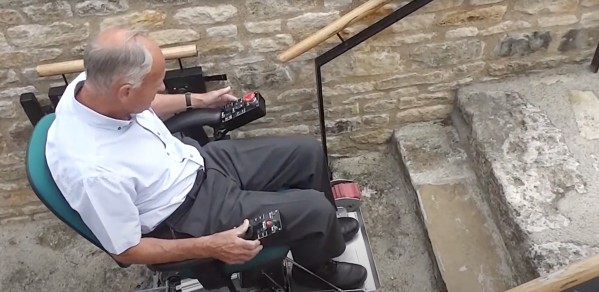
Alumni Chris Mack and John Ross recently got in touch to to share the story of the design and creation of their stair-climbing mobility vehicle.
We have developed a go-anywhere mobility vehicle that is sufficiently compact to fit through doorways and corridors in a standard house, can be easily transported in an estate car, and can safely climb and traverse uneven ground and staircases of up to 40 degrees, with the operator always facing forward.
John Ross co-founder of IGAN
They have developed a go-anywhere mobility vehicle that is sufficiently compact to fit through doorways and corridors in a standard house, can be easily transported in an estate car, and can safely climb and traverse uneven ground and staircases of up to 40 degrees, with the operator always facing forward.
Chris and John (both St. John’s, 1961) created a brief for a tracked mobility vehicle then John took over the practicalities of design, manufacture and development of the prototype, as he had just retired. After graduating, John has been involved in many engineering projects, mostly with some link to cryogenics and superconductivity. One such project resulted in the world’s largest, commercially made, superconducting magnet for use in particle physics research at Frascati in Italy; another recent project was working with Alan Sykes, who was the pioneer of an innovative fusion energy concept, a “spherical tokamak”, at Tokamak Energy Ltd.
The initial design work on the stair-climbing mobility vehicle showed promise and in 2016 a small company was set up on a voluntary basis to design and prove the concept. The company is named IGAN an acronym for I Go Anywhere Now. Some assistance was obtained via government grants (SEIS support and Research and Development tax relief) with additional support from colleague, Alan Sykes.
As would be expected, pitfalls were encountered along the way: not least of these was the sourcing of the two main drive motors. During the trials, considerable benefit was found in being able to control the position of the seat, and thus the centre of gravity of the vehicle, to improve its operation. The design of the tracks also needed several iterations to reach the chosen design. Although much of the work has been mechanical and electrical, the control aspects were the most challenging.
As far as is known, the project is believed to be unique in that the user faces forwards at all times. Competing designs need the user to face downhill when climbing stairs, which is seen as a significant problem for a novice user on domestic stairs.
The prototype has been tested by both young and elderly users, to assess its usability and has been well received by both for its ease of use and appearance.
The IGAN team are now seeking to capitalise on the work by selling the entire concept to an organisation able to make it into a commercial success. This includes a patent which has recently been granted to the company, covering many aspects of the design.

